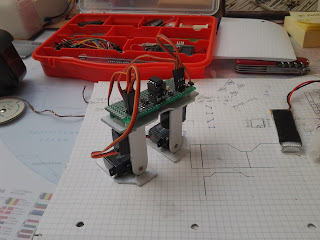Although wheeled robots would be better for beginners I wanted to build a legged robot. Mostly because there were no continuous motors in reach and my attempt to modify a servo failed miserably.
One of the
simplest solutions is a biped robot that moves as it shifts its weight. Two
servos are needed for the feet and another two to move the legs to go forward
or backwards. It is boring to just make the robot walk until the batteries are
dead. So I decided to use infrared to receive commands.
The whole
thing would be way too easy if you could just plug the servos into an Arduino.
A small 90ct Attiny85 chip has 5 (actually up to 6) programmable pins which is
enough for the project. There is a nice tutorial about how to program the
Attiny over an Arduino:
The real problem was finding libraries for servos and infrared:
The infrared
sketch works fine with my TV remote so I only had to change the codes.
On the hardware side I used aluminum and a lot of glue. The feet have rubber soles to prevent the robot from ruining the furniture. A prototyping PCB was cut in
half to connect the few components. Four turnigy 1800A servos are running well
with the 3.7V battery, there are no clocks or voltage regulators. The Attiny
itself is not soldered in, it can be taken away easily for programming.
I would say the project was successful although I did not have the time to program it well (making turns is still difficult). The solution is also very cheap because of the small microcontroller. The only relatively expensive thing is an Arduino for programming.
I would say the project was successful although I did not have the time to program it well (making turns is still difficult). The solution is also very cheap because of the small microcontroller. The only relatively expensive thing is an Arduino for programming.









What Victorinox do you use?
ReplyDeleteA Climber
DeleteVery nice project!!! I am going to try this design over the summer. I can't wait!
DeleteWhere a find the schematic and the code please
ReplyDeleteKind Regards
Here are all the Arduino sketches I could find:
Deletehttps://www.dropbox.com/s/hnhc22r07min653/Biped_Firmware_tiny_0_3IR.zip?dl=1
There is no real schematic to this. You will have to look into the code to find out how the pins are wired.
Hai Max,
DeleteIt is fast (very fast) thanks for that
Kind Regards
plz post one more photo of circuit
ReplyDeleteplz it will help me a lot
excellent design...you are great
ReplyDelete